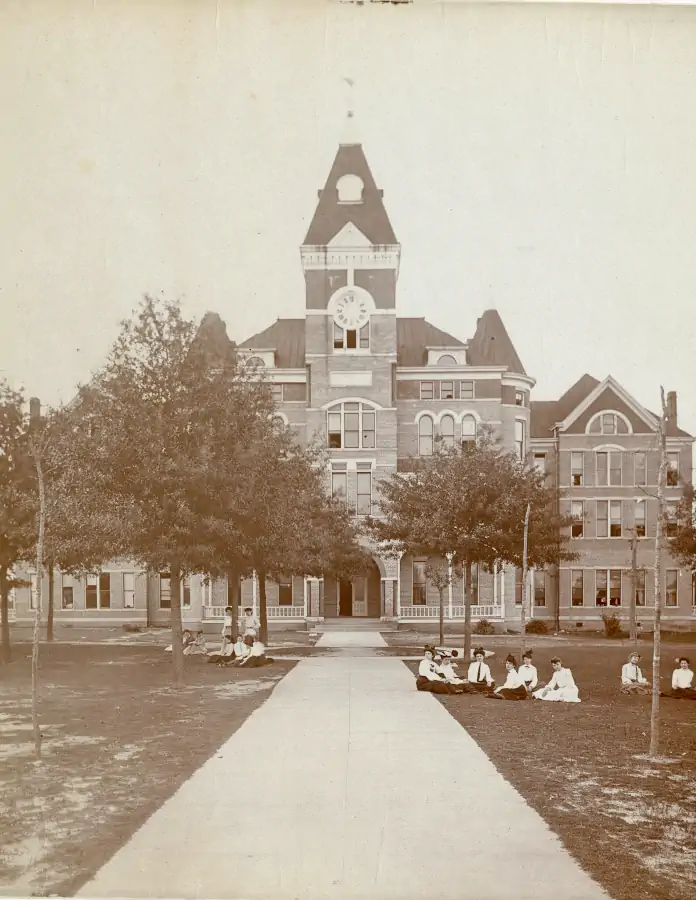Old Main

Dates
- Built: 1890-1892
- Removed: 2/3/1914 (Fire)
Location Accuracy
- Location approximate based on photographs, measurements of still-existing walkways, and the approximate locations of Key Hall and College Hall.
Map
History
Old Main served the College for all its activities and services through its founding and formative years. Combining elements of various architectural designs, the large three-story building of red brick was constructed in three stages: the east wing; the main, or center, section; and the west wing. Though the contractor was "pushing work along rapidly", the east wing, to have been completed by September, was not ready until October 15. The rest of the building was "only a promising pile of brick". Only the foundation for the center and the west wing had been laid.
In April, 1891, because of lack of money, work on the building had stopped. Friends of the College called a mass meeting of the prominent citizens on April 6, "to devise some means to raise money to complete" the structure. Dr. McLauchlan, Dr. J. B. Harvey, R.W. Huie, C. C. Henderson, and Rev. H. M. Whaling "made able and stirring speeches". Several men increased their pledges, leaving only $8,000 to be raised. They agreed that it would be a "burning shame upon the enterprising citizens of Arkadelphia and South Arkansas to allow this great enterprise to 'fall through' after its success is almost assured".
As a result of local efforts, contractor Patrick Powers was able to resume the work on November 3, 1891, and to complete the construction of the main section and the west wing in 1892. In May, 1892, the work was "going right along on the Methodist College" and was "progressing finely and chapel hall will be completed in time for the commencement exercises".
Each portion of the "imposing brick structure" served specific purposes. The east wing contained the President's apartment, dining hall, kitchen, bedrooms, bathrooms, and elevator. The main building included the President's office, parlors, library, primary rooms, study hall, gymnasium, business department, and bedrooms. The west wing contained the concert hall, science rooms, art studio, music room, and elocution hall.
The building was well equipped for its purposes. All of the classrooms were furnished with appropriate apparatus. "The magnificent concert hall" featured an inclined floor "seated with opera chairs", and the stage displayed a "handsome drop curtain." The furnishings, "always of the best," had been installed at a cost of $15,000 to $20,000, which increased the value of the property to $60,000 in 1897.
On the walls of the main entrance hall were "a number of immense paintings", among them "a fine copy" of Rosa Bonheur's Horse Fair, Gabriel Max's The Lion's Bride, Emile Renouf's Helping Hand, and Heinrich Hofmann's Othello. Some copies were the work of Mrs. Lelia Lauralette Jones, who received the premium for the best oil paintings at the Clark County Fair in 1891. The parlors, "also exhibiting some splendid paintings", were "elegant and with the library and President's office on the grand entrance hall, formed a set of reception rooms not surpassed by any college".
The dining hall was "large, well-ventilated, and always supplied with the best the market afforded". Because of its "fortunate situation, in a splendid farming community," the College could purchase eggs at 10¢ a dozen; "butter, the very best, 15¢ a pound; potatoes, 40c; and the very fattest and best of beef and pork at from 4¢ to 6¢"a pound; "wood for furnace $1.50 per cord, and servant hire less than half in city". At mealtime, the "teachers, president, and pupils all share alike and dine together".
The bedrooms were "handsomely furnished with carpet, marble-top washstands, and dressers with large mirrors. All the conveniences of water-works are on every floor." In addition, the building was "lighted by electricity", installed by 1892-93; and time was "regulated by electric bells". The students had two minutes to change from classroom to classroom.
By the time of its completion in 1892, the building had cost over $40,000, or more than $6,000 above the contract price of $33,900. This unexpected increase of over $6,000 contributed further to the financial problems of the College.
In 1902, President Jones had a steam heating system installed in the building at a cost of $5,000. In other renovations, according to Business Manager J. S. Hawkins, "a complete rehauling of the building was going on in August and September, with every bed room being nicely papered, etc." In 1906, it had been equipped with three fire escapes at a cost of $180.00 for an "up-to-date system" for the safety of the girls in the dormitory on the third floor. The building started in 1890 continued to serve as the main structure until 1914. "Plain, quiet, imposing," the structure was still "well adapted for school purposes, pleasing, convenient, comfortable, satisfying".
During its early struggle for survival, the College suffered its chief blow in the destruction by fire of the Main Building in the early morning hours of February 3, 1914. Henderson replaced the building with College Hall and a separate kitchen and dining hall in 1915, but had to make do with temporary buildings until they were finished.